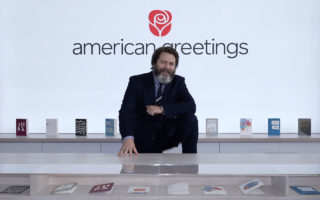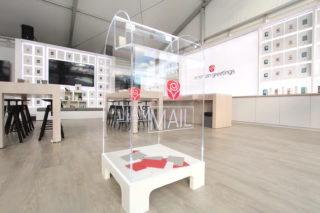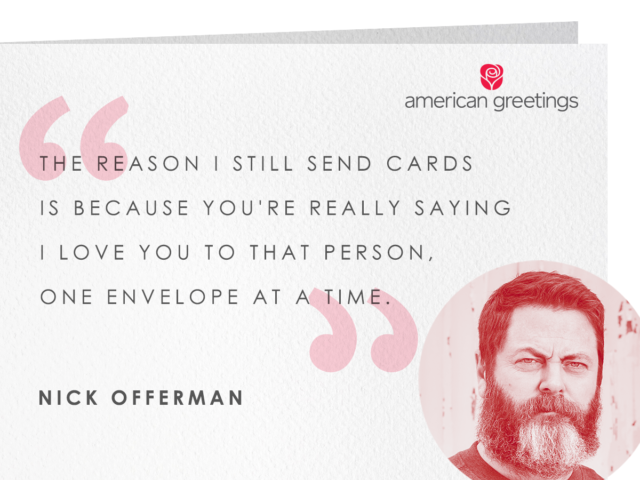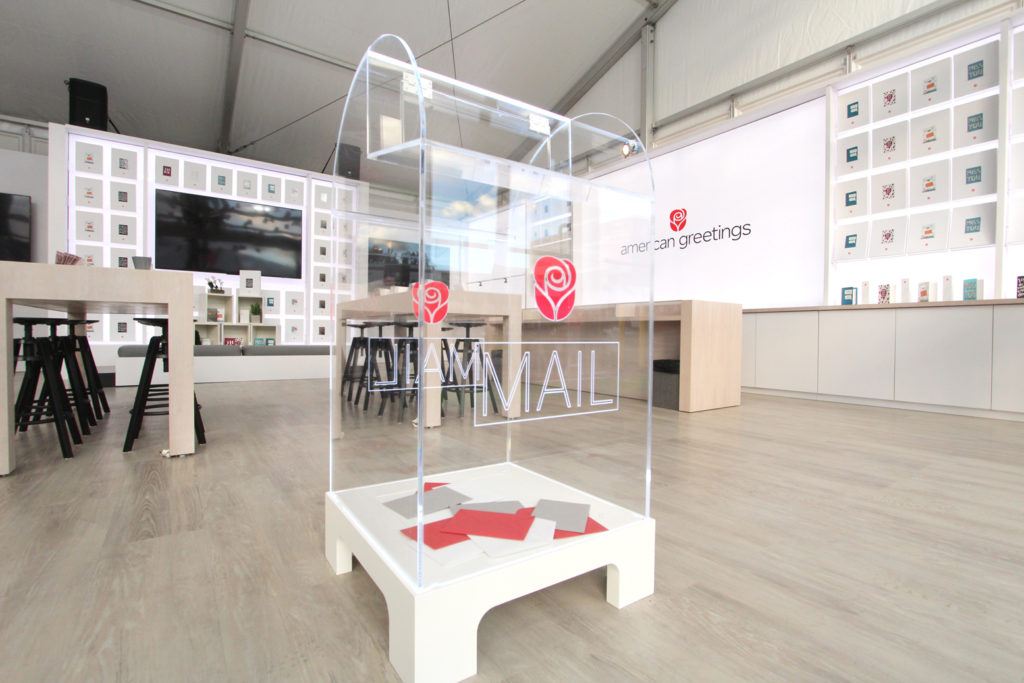American Greetings is using its paper card to have a tongue-in-cheek talk with techies about the importance of the most powerful messaging device on the planet—written communication.
The 111-year-old Cleveland-based greeting card company travelled to Sin City and CES for the first time earlier this month to introduce a “Device Like No Other,” a product billed as having “unlimited memory, is ultra-thin and has more powerful ways to connect than you ever thought possible.”
Spoiler alert: The device is still a greeting card, and actually an experiential marketing move to have meaningful conversations and connect with consumers in the midst of arguably the world’s most chaotic trade show.
The American Greetings Connection Hub just outside of the Las Vegas Convention Center demonstrated how greeting cards still matter and do just as good of a job—if not better—in sharing a powerful message.

Actor Nick Offerman (Parks and Recreation, Fargo) and New York Times best-selling author Randi Zuckerberg helped introduce the “Device Like No Other” and talked about the importance of cultivating relationships using the technology for the right occasions.
“I was sincerely honored to be asked to represent the venerated sentiment-delivery system known as the greeting card by American Greetings,” said Offerman. “In my family, we rely on cards to signify moments of great magnitude as well as just simple affection, a warm practice I am happy to share with my fellow Americans.”
“In this fast-paced world, the most valuable thing you can give someone is your time and creative energy. No matter how high-tech we are, there is truly nothing like receiving a handwritten card and is one of the few things in my life where I can say “there’s no app for that,’” said Zuckerberg. “That’s why I’m so thrilled to be partnering with American Greetings to remind people that tech is wonderful, but sometimes you need to unplug in order to truly connect.”
This isn’t the first time American Greetings—which generates annual revenue of approximately $1.9 billion—has crashed a tech show to say “slow down!” At SXSW in Austin last year, they left a footprint during the Interactive portion of the festival with their experiential “Analog” activation.
Alex Ho, executive director of marketing for American Greetings, sat down with [a]listdaily to discuss the brand’s approach to connecting with consumers and how they’re encouraging them to take breaks from the digital revolution.

Why was American Greetings at CES earlier this month?
We were there to do what pretty much every other company comes to CES for—which was to talk about our technology and make a product announcement in the ‘Device Like No Other.’ The punch line is that if there is a ‘Device Like No Other,’ it’s a greeting card. We were at CES to send a message and a reminder that greeting cards are complementary to all of the digital communication that’s happening right now. The environment was calm, and not noisy like most of the other booths. Consumers found a moment to take a breath and look inward. We allowed people to customize limited-edition CES greeting cards, mini gifts or 30-second shareable Instagram videos. We were very happy with our presence and consumer response. Whenever we look at our next event, we’ll have to look at it from the context of our objectives. We enjoy putting them on. We intend to do things different with the experiences. But the message remains the same.
What is the mission behind the “Device Like No Other”?
What we found out throughout consumer research is that consumers today are using greeting cards in different ways. Our business has been stable throughout the entire rise of social networking over the past 10 years. Now they have more convenient electronic devices to connect digitally, visually and frequently. Amongst that entire volume of communication, what they’re missing is the deeper, more meaningful connections that people really care about. That’s what greeting cards do.
Does your experiential marketing move hit closer to home for people who are traveling at a trade show?
The reason why the experience and space is like that is to demonstrate the importance of personalized, written communication, and what that means. We’re finding that consumers in the space are engaging with us and actually telling their own stories about greeting cards they’ve received in the past, or kept, or specifically about the people they are writing it for. It’s really raising awareness about personalized communication.
How has the American Greetings brand message evolved? How are you re-telling your story today?
American Greetings is a purpose-driven company. Our brand positioning is to make the world a more thoughtful and caring place. When we attend events, we want to make those places a more thoughtful and caring place, too. The brand message and tonality is around being real, authentic and creating meaningful connections. People are responding to us.

Although American Greetings is about advocating written communication, how are you trying to have ownership and an identity in the social space?
The interesting part about our message is that greeting cards and digital are not at war with each other—they’re complementary. While we’re asking people to actually create cards, we’re using social media for what it’s best at—sharing, reaching out and connecting with people on a digital level. With our product launch with Nick Offerman, we used Periscope and Facebook Live to broadcast our announcement. We’re also using all of the social channels that are appropriate for our heavy visual art categories. But we’re continuing to look at other emerging platforms as they develop to see if they are appropriate for our audience base.
Nick Offerman doesn’t need much of an introduction, and he’s an influencer on a grand scale. Do you have an influencer marketing strategy?
Our influencers, which in addition to Nick included Randi Zuckerberg, are authentic and have a high reach and a footprint with their established social audience. We brought them so they can tell their own stories, and why they are important in life. We’re not digital people. We’re not marketing people. We’re just people. Humanity needs that kind of connection and emotional resonance. Their audience is large because people want to hear from them. What they believe is complementary to what we believe, so that’s how we chose our influencers.

As a marketer, what are the challenges you are trying to overcome?
As all media channels mature and evolve, there is some level of plateauing. Executives are constantly looking at their media mix between display, search, native and content. We are constantly doing the same, too. Tent pole events need to be complemented by a constant stream of content and marketing every day as well in order for your KPIs and brand message not to erode.
What is the consumer feedback from the brand message you have been sharing in the last year?
People may be surprised when they see us at SXSW and CES among the hardcore, digital-centric brands and people. But the opposite is happening for people who you think might dismiss it. We’re finding that once people get the tongue-in-cheek joke about our ‘device,’ they’re really embracing it. We’re always focused on consumer insights and consumer learnings. What we’re finding is that millennials are the fastest growing segment for greeting cards. They are actually over-indexing on their fair share of buying greeting cards. When you look at that fact, combined with this idea of digitally connected people wanting to differentiate their social media friends from their real friends, it makes sense why greeting cards continue to have a role in today’s communication landscape.
Follow Manouk Akopyan on Twitter @Manouk_Akopyan

